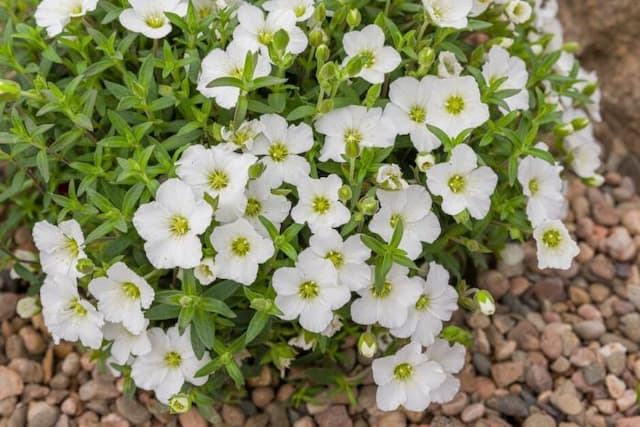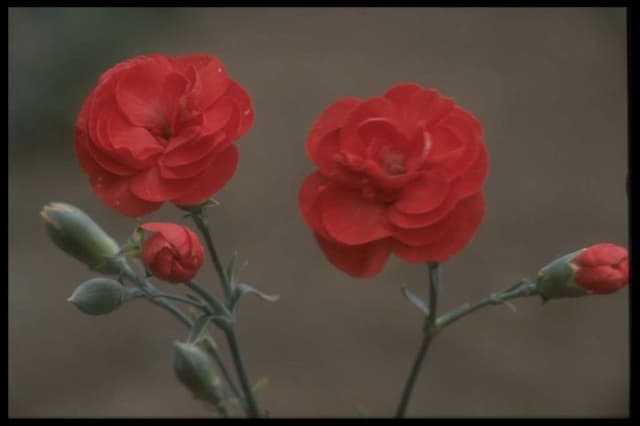Sweet William Dianthus 'Marion Robinson' (b)

ABOUT
Dianthus 'Marion Robinson' is a charming plant known for its vibrant and engaging appearance. It typically boasts a profusion of flowers that exhibit a striking color palette often with contrasting hues. The blossoms are renowned for their radiant pigmentation which makes them a focal point in any garden. Each flower is comprised of petals that can vary in shape from rounded to deeply fringed or serrated, offering a delightful texture that is as pleasing to the touch as it is to the eye. The foliage of the plant provides a lush background for the bright blooms. The leaves tend to be slender and elongated, presenting a lovely shade of green that contrasts nicely with the brilliant colors of the flowers. They may have a blue-green or grayish tint, depending on the variety, which adds another visual dimension to the plant's overall appeal. The habit of growth tends to be clumping or mounding, creating dense tufts of foliage and flowers that can give a full and abundant presence in the landscape. Moreover, Dianthus 'Marion Robinson' flowers are celebrated for their delightful fragrance. The scent can be spicy or sweet, and it carries well, inviting visitors to linger and enjoy. The combination of striking visuals and a pleasant aroma makes this plant a prized element in gardens designed for sensory allure.
About this plant
 Names
NamesFamily
Caryophyllaceae
Synonyms
Sweet William, Pinks
Common names
Dianthus 'Marion Robinson'
 Toxicity
ToxicityTo humans
Dianthus 'Marion Robinson', commonly known as a variety of Carnation or Pink, is not considered toxic to humans. In general, carnations are not known to cause poisoning if touched or ingested, and they are often used in the culinary world—particularly their petals—in desserts and salads. However, sensitive individuals may experience mild skin irritation or an allergic reaction when handling the plant. Consuming large quantities may potentially cause stomach upset, but significant poisoning is rare.
To pets
Carnations, including the Dianthus 'Marion Robinson', can be mildly toxic to pets if ingested. While they are not severely poisonous, consumption of the plant material can lead to gastrointestinal upset in cats and dogs. Symptoms of ingestion may include vomiting, diarrhea, and mild dermatitis if there is prolonged skin contact. Though serious complications are unlikely, it is still best to keep pets from chewing on carnations, and if a pet appears to be ill after ingestion, consult a veterinarian.
 Characteristics
CharacteristicsLife cycle
Perennials
Foliage type
Evergreen
Color of leaves
Blue-green
Flower color
Pink
Height
1 foot 4 inches (0.41 meters)
Spread
1 foot (0.3 meters)
Plant type
Herb
Hardiness zones
5
Native area
Europe
Benefits
 General Benefits
General Benefits- Landscaping Aesthetics: Adds vibrant color and texture to garden beds, borders, and containers.
- Easy to Grow: Known for being hardy and low-maintenance, suitable for gardeners of all levels.
- Long Blooming Period: Produces flowers from late spring to early fall, offering extended visual interest.
- Attracts Pollinators: The flowers attract bees, butterflies, and other beneficial insects to the garden.
- Drought Tolerance: Once established, it has good drought resistance, requiring less frequent watering.
- Frost Tolerant: Can survive light frosts, making it suitable for a variety of climates.
- Compact Growth: The plant's mounding habit makes it ideal for small spaces or as a ground cover.
- Cut Flowers: Their blooms are suitable for cut flower arrangements, adding beauty indoors.
- Variety of Uses: Can be planted in rock gardens, as edging, or in mixed perennial beds for versatility.
- Deer Resistance: Less likely to be eaten by deer, which can be beneficial in areas with wildlife.
 Medical Properties
Medical PropertiesThis plant is not used for medical purposes.
 Air-purifying Qualities
Air-purifying QualitiesThis plant is not specifically known for air purifying qualities.
 Other Uses
Other Uses- Culinary Garnish: The petals of Dianthus 'Pinks' can be used to add color and a light spicy flavor to salads or desserts.
- Dye Production: The flowers of Dianthus 'Pinks' can be used to create a natural dye for fabrics or artisanal crafts.
- Crafts: Dried Dianthus 'Pinks' flowers are often used in potpourri or as a natural confetti at celebrations.
- Ice Cubes: Petals of Dianthus 'Pinks' can be frozen in ice cubes for a decorative touch in beverages.
- Eco-Friendly Soap Making: The blossoms are sometimes included in homemade soaps for their texture and fragrance.
- Floral Arrangements: Dianthus 'Pinks' can be used as filler flowers in bouquets to provide a delicate structure and a pleasant scent.
- Candle Making: The scent of Dianthus 'Pinks' can be extracted and used in the creation of scented candles.
- Bedroom Freshener: A bouquet of Dianthus 'Pinks' can naturally perfume a room without the need for artificial air fresheners.
- Scented Letters: Historically, petals of Dianthus 'Pinks' were included in letters to impart a sweet fragrance as they were opened.
- Photography: Dianthus 'Pinks' provide a picturesque element in still life photography due to their vibrant colors and intricate forms.
Interesting Facts
 Feng Shui
Feng ShuiThe Carnation is not used in Feng Shui practice.
 Zodiac Sign Compitability
Zodiac Sign CompitabilityThe Carnation is not used in astrology practice.
 Plant Symbolism
Plant Symbolism- Love: Dianthus, known also as "pinks," often symbolize love and admiration. The name “dianthus” itself comes from the Greek words "dios," meaning divine, and "anthos," meaning flower, effectively calling it the divine flower or flower of the gods, which is often associated with emotions of love.
- Boldness: The vivid and bright colors of the Dianthus 'Marion Robinson' can represent boldness and audaciousness. This is reflected in the way the flower makes a strong visual statement in gardens and bouquets.
- Pure Affection: Pinks, like Dianthus 'Marion Robinson', are also associated with pure affection, perhaps due to their long association with sentiments expressed in the Victorian language of flowers (floriography), where flowers were used to communicate feelings that could not be spoken aloud.
- Passion: The rich, typically pink, red, or purple colors of the Dianthus 'Marion Robinson' blooms also suggest feelings of passion and romantic dedication, making them a common choice for expressing intense romantic feelings.
 Water
WaterThe Sweet William requires consistent moisture but does not like to be waterlogged. It should be watered when the top inch of soil feels dry to the touch. A good method is to water at the base of the plant to avoid wetting the foliage, which can lead to diseases. During active growth, especially in the absence of rainfall, water Sweet William with about one inch of water per week. Adjust your watering routine to more frequent intervals during periods of high heat or drought to ensure the soil remains consistently moist but not saturated.
 Light
LightSweet William thrives best in full sun conditions, where it can receive at least six hours of direct sunlight daily. A location that provides morning sunlight and some afternoon shade is ideal, as intense heat during the peak afternoon hours can stress the plant. Adequate sunlight is essential for the plant to produce its characteristic vibrant flowers and maintain healthy growth.
 Temperature
TemperatureSweet William prefers cooler temperatures and can tolerate a range from about 40 degrees Fahrenheit as a minimum to about 85 degrees Fahrenheit as a maximum. The ideal temperature range for promoting robust growth and flowering is between 60 and 70 degrees Fahrenheit. They can handle light frosts but should be protected from extreme cold or sustained freezing temperatures.
 Pruning
PruningPruning Sweet William is essential for promoting healthy growth and abundant blooms. Deadhead spent flowers regularly to encourage further blooming and to maintain a tidy appearance. After the main bloom period is over, cut back the stems to encourage a second flush of flowers. The best time to prune for shape and size is in late winter or early spring before new growth begins.
 Cleaning
CleaningAs needed
 Soil
SoilThe best soil mix for a Carnation (Dianthus 'Marion Robinson') should be well-draining, loamy or sandy, and enriched with organic matter. Ideal pH for Carnations ranges from slightly acidic to neutral, around 6.0 to 7.0. A mix of two parts garden soil, one part sand, and one part compost or well-rotted manure can create a suitable growing medium.
 Repotting
RepottingCarnations (Dianthus 'Marion Robinson') generally require repotting every one to two years. They should be repotted when they outgrow their current container or when the soil is depleted of nutrients.
 Humidity & Misting
Humidity & MistingCarnations (Dianthus 'Marion Robinson') prefer moderate humidity levels, as too high humidity can promote fungal diseases. Aim for a humidity level around 40% to 50% for optimal growth.
 Suitable locations
Suitable locationsIndoor
Place Carnation near a sunny window; ensure ample light.
Outdoor
Plant Carnation in full sun, shelter from strong winds.
Hardiness zone
3-9 USDA
 Life cycle
Life cycleDianthus 'Marion Robinson', commonly known as the 'Marion Robinson Carnation', starts its life cycle when seeds are sown in late winter to early spring or by cuttings taken in summer. Germination occurs in a moist environment with good light exposure, with seedlings emerging in a couple of weeks. Once the seedlings develop true leaves and are large enough, they are transplanted into their final growing location where they require well-drained soil and full sun. The plant enters a vegetative growth stage where it produces a clump of grey-green leaves and sturdy stems. Flowering typically occurs in late spring to early summer, showing off fragrant, frilly-edged blooms that may attract pollinators. After blooming, the plant may either be deadheaded to encourage more blooms, or if allowed to go to seed, it can complete its cycle by producing seeds for the next generation before entering a dormant stage in the colder months.
 Propogation
PropogationPropogation time
Spring-Early Summer
Propogation: Dianthus 'Marion Robinson', popularly known as Pinks, is often best propagated through stem cuttings. This is typically done during late spring or early summer as the plant enters a phase of active growth, making it easier for cuttings to root. To propagate via stem cuttings, select a healthy, non-flowering shoot and cut a 4- to 6-inch-long (10-15 cm) section. Ensure that the cutting has several sets of leaves. Remove the lower leaves to create a clean stem which will be inserted into the rooting medium. Prepare a pot with a mixture of peat and perlite or sand to ensure good drainage and stick the stem cutting about an inch (2.5 cm) deep into the soil. It is crucial to maintain consistent moisture while avoiding waterlogged conditions and to provide the cutting with indirect light. Roots should develop within a few weeks, after which the new plant can be gradually acclimated to direct sunlight before planting out into the garden.


![Pink [Tequila Sunrise]](/_next/image?url=https%3A%2F%2Fplants-admin.emdemapps.com%2Fimages%2Fplants%2F%2Fimages%2F604b5d995d06e.png&w=640&q=75)






